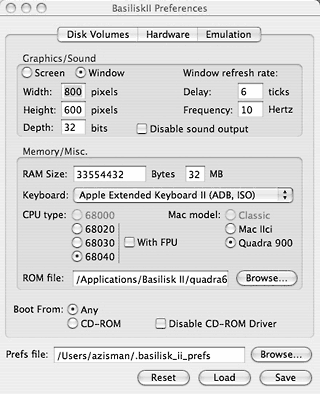
- #Using disk copy in basilisk ii drivers
- #Using disk copy in basilisk ii pro
- #Using disk copy in basilisk ii zip
Once I saw the posts about performance problems with Lido-formatted images in modern replacements such as BlueSCSI and RaSCSI, I started formatting new disk images with other tools.
#Using disk copy in basilisk ii drivers
I also grabbed a number of disk images for which I had no idea how those were formatted or which drivers were installed. I started with disk images over a year ago and not knowing what we all know now. I’ll second what said - the Disk-O-Matic part of Disk Jockey is fantastic! Here is my use case. Parsons Engineering FocusDrive partitioning (allows up to 30 partitions).///SHH Systeme MicroDrive partitioning (allows up to 16 partitions on IDE hard drives).CFFA-style partitioning (fixed-size 32MB/1GB volumes, for Compact Flash cards).Macintosh-style disk partitioning (for hard drives, CD-ROMs, flopticals, etc).ProSel Uni-DOS / DOS Master (one or more DOS volumes embedded in an 800K ProDOS disk).UNIDOS / AmDOS / OzDOS (two 400K DOS volumes on an 800K disk).CiderPress also recognizes the following "meta-formats": Files on CP/M and RDOS disks can be extracted and viewed. Create subdirectories and change file types on ProDOS disks. Change disk volume names and DOS volume numbers. You can view, add, extract, rename, and delete files, as well as create bootable blank disk images. SSI's RDOS (13-sector, 16-sector, and converted 13-to-16-sector formats)ĭOS, ProDOS, HFS, and UCSD Pascal filesystems are fully supported.Images larger than floppies, such as ProDOS and HFS hard drive partition images, are fully supported. The settings can be overridden if necessary. The image file format, filesystem, and sector ordering are determined automatically for most disks. ShrinkIt (NuFX) compressed disk images (.shk.
#Using disk copy in basilisk ii zip
#Using disk copy in basilisk ii pro

HFS+ also implements Hot Clustering, which optimizes the location of the most accessed files so that the drive head moves as little as possible. Some bits are at the beginning, some are at the end, and some are in the middle.


The issue I'd face is that HFS can (and does) write parts of your files anywhere on the volume. So, yes, if it's a 2 GB volume that only contains a handful of small files, that's a lot of wasted space. Click to expand.That's an interesting idea!Ĭurrently, it creates an image the same size as the volume on the device you're extracting it from (not just a 2 GB one).


 0 kommentar(er)
0 kommentar(er)
